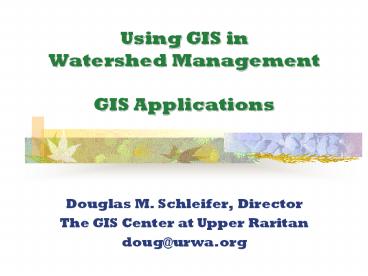Using GIS in Watershed Management GIS Applications PowerPoint PPT Presentation
1 / 13
Title: Using GIS in Watershed Management GIS Applications
1
Using GIS in Watershed ManagementGIS
Applications
- Douglas M. Schleifer, Director
- The GIS Center at Upper Raritan
- doug_at_urwa.org
2
Process
- Define the issues
- Generate strategies
- Incorporate GIS applications
3
Issues, Mandates and Opportunities
- Public Education
- Nonpoint Source Pollutant Loadings
- Stormwater Management
- Flood Damage Reductions
- Surface Water Control Plans
- Water Quality Assessment
- Open Space for Watershed Protection
- Water Supply Management
- Wastewater Management
- Land Development Management
- Aquatic Habitat Restoration
- From the Raritan Basin Watershed Management
Project
4
Generate Strategies
- Preservation
- Restoration/Remediation
- Management
5
Applications for Analysis
- Soils
- Impervious surfaces
- Land use/landcover
- Groundwater recharge
- Riparian areas
- Open space
6
Scale
Basin
Sub-basin
Watershed
Sub-watershed
- Watershed Management Areas, as defined by
NJDEP, are on the basin or sub-basin scale.
7
Soils
The following information can be derived by
linking soils data with the Soil Survey
Geographic Database (SSURGO)
- Erodibility
- Agricultural capability
- Development suitability
- Septic absorption fields
- Lawns and landscaping
- Dwellings
- Small commercial buildings
- Local roads and streets
8
Impervious Surfaces
- Impervious surface estimations can be
derived from land use/landcover data.
The NEMO (Nonpoint Education for Municipal
Officials) Project, developed an analytical
methodology that
correlates the amount of impervious surfaces in a
watershed to impacts on stream quality. The
chart on the right can be used as a guide to
develop strategies for preservation, restoration
or management, depending on the level of
impervious surface.
9
Land Use/Landcover
- These data can be used to calculate change
in over a period of time of the following land
use/landcover types - Urban land
- Agricultural land
- Forest
- Water
- Wetlands
- Barren land
- These data can be used to inform analyses,
such as groundwater recharge, riparian areas and
open space.
10
Groundwater Recharge
- Use the methodology described in NJ Geological
Survey publication GSR-32. It combines land
use/landcover, soils and precipitation data to
estimate the amount of groundwater recharge for
any area in NJ. - Preservation strategies for areas of high
groundwater recharge should be considered.
11
Riparian Areas
To create riparian areas data, combine relevant
features into one GIS data set.
- Water
- Adjacent wetlands
- Wetland transition areas
- Flood areas
- Adjacent hydric alluvial soils
Additional features
- Wildlife corridor
- Adjacent steep slopes
To quantify current riparian areas, remove areas
of development using land use/landcover data.
To evaluate riparian health, determine the extent
of forest crown closure, impervious surfaces and
barriers and alterations to stream flow such as
managed stream segments, dams and road crossings.
12
Open Space
To visualize and prioritize future open space
acquisitions, view GIS data that fit the
specified objectives for acquisition with
existing open space, easement and parcel data.
These data may include, but are not limited to,
the following physical and cultural features
- Water, wetlands, transition areas, flood hazard
areas. - Areas with high capacity for groundwater
recharge, wellhead protection areas. - Forests, steep slopes, wildlife corridors,
habitat for threatened and endangered species. - Farmland, significant soils.
- Historic sites and districts, hiking and biking
trails.
13
Resources
- For further information, consult the following
resources - Raritan Basin Watershed Management Project
raritanbasin.org - NEMO (Nonpoint Education for Municipal Officials)
Project
nemo.uconn.edu - Center for Watershed Protection
www.cwp.org

